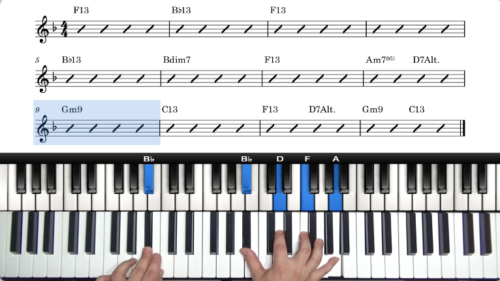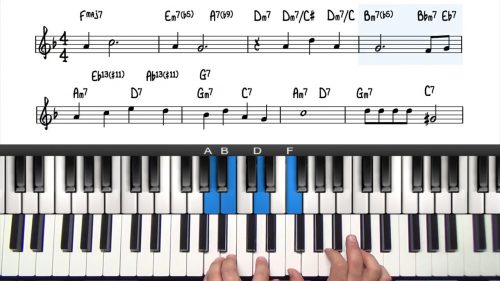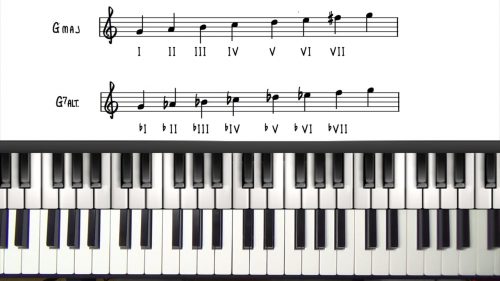16th Note Improvisation – “Sassy” Transcription
Welcome to part 2 of this transcription tutorial on the tune “Sassy” by Wynton Kelly.
In the last lesson we talked about the importance of transcribing from your favourite players and playing along with the recordings to develop your sense of swing. Playing along with swingin’ records is the best way to improve your swing feel and imitate the sounds of the masters of jazz.
In this lesson we will play the first 12 bars of Wynton’s solo that we covered in the last lesson, and also move onto the next 24 bars of his solo which contains some more complex improvised material.
Swing 8th-Notes, Triplets, & 16th-Notes
Previously in this course we have just explored improvisation exercises using swing 8th-notes and triplets. In this part of the solo, we explore Wynton’s use of 16th-note lines.
This incorporates the theory that we have studied previously in this course, in particular using chromaticism in your improvised lines We explore Wynton’s use of chromaticism in his 16th note runs.
Motif Development
We will also analyse some interesting examples of motif development. This is a core part of improvisation and will add more structure and coherency to the lines and ideas that you are playing.
Stating, repeating, and developing motifs will help you tell a story and set a narrative in your improvised solos.
Lesson Downloads
-
Jazz Blues Voicings File Type: pdf
Practice Tips
-
Playing along with the recordings that you like the sound of is one of the most effective ways to develop your jazz feel.
-
The first step is to transcribe the notes that you are hearing on the recording and then work out the rhythmic placement of the notes.
-
At this point you can start to play along with the record and try to get it as close as possible to the original recording.
-
Once you are feeling more comfortable with this, you can then try to play the solo with the iRealPro App with voicings in your left hand.
-
Add notes into the lines, take notes out, change the rhythmic placement, change the point of resolution etc...
-
Use the ideas as a springboard to develop your own improvised material.






I’m still a little confused about transcribing. When you transcribe, do you go over and over a short section, then write it out using Musicscore or similar software? Or do you memorize a little bit at a time?
Hi Kirk,
Thanks for the great question – there was a website bug where I wasn’t notified of all comments and it seems this comment was one of them.
Personally I don’t notate full transcriptions, but I will notate a specific lick or line that I like, for example over a 251 or other common progression. I compile these in a Sibelius document that I can add to. This can be useful to not forget the material that you transcribe, and you can start to compile a “book of licks” that you can revisit once a week or so to keep them all fresh in your memory and also note which ones you have transposed and into which keys, similar to our practice planners.
I personally find it is very effective is to transcribe a lick or short piece of vocabulary, and then immediate apply it to the same progression in another tune, and also transpose it into different key(s) and apply to tunes in other keys. For me this is the most effective way to make a line ‘stick’ in my memory.
Also understand that most 251 licks or ideas, can be used over the 251 in the relative major/minor key. For example when playing “autumn leaves”, any lick that works over the 251 in Bb Major, will work over the 251 in G Minor, without changing any of the notes, see Tuomo’s course here which explores this topic and other relationships too:
https://www.pianogroove.com/jazz-piano-lessons/advanced-improvisation-course/
I hope that helps Kirk – let me know if you have any other questions.
Cheers, Hayden
Hi there, Same question as Kirk. I’m curious if you write out your transcriptions or commit it to memory as you go. I’ve tried memorizing as I go in the past but then it’s frustrating to be set back when starting up the next day or two days later, trying to remember previous portions.
It would be interesting to hear your method. Thank you!
Hi Christoper,
Thanks for the comment – there was a website bug where I wasn’t notified of comments and it seems Kirk’s comment was one of them. I will reply to his answer too.
Personally I don’t notate full transcriptions, but I will notate a specific lick or line that I like, for example over a 251 or other common progression. I compile these in a Sibelius document that I can add to. This can be useful to not forget the material that you transcribe, and you can start to compile a “book of licks” that you can revisit once a week or so to keep them all fresh in your memory and also note which ones you have transposed and into which keys, similar to our practice planners.
I personally find it is very effective is to transcribe a lick or short piece of vocabulary, and then immediate apply it to the same progression in another tune, and also transpose it into different key(s) and apply to tunes in other keys. For me this is the most effective way to make a line ‘stick’ in my memory.
Also understand that most 251 licks or ideas, can be used over the 251 in the relative major/minor key. For example when playing “autumn leaves”, any lick that works over the 251 in Bb Major, will work over the 251 in G Minor, without changing any of the notes, see Tuomo’s course here which explores this topic and other relationships too:
https://www.pianogroove.com/jazz-piano-lessons/advanced-improvisation-course/
I hope that helps Christoper – let me know if you have any other questions.
Cheers, Hayden
Thanks so much for these blues courses. Many people start off their Jazz journey with blues because it’s supposed to be the most basic jazz form but I’ve always found improvisation over blues really difficult because there are so many permutations, with tones that just don’t seem to make harmonic sense in “straight” jazz. But the way you analyse the transcriptions in the last two lessons in particular has helped me to understand the thinking process involved. I think I’m slowly overcoming the mental block I have related to blues improvisation.